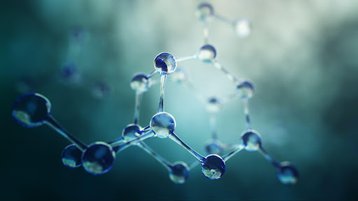The convergence of cutting-edge technologies, including Artificial Intelligence (AI), cloud computing, and quantum chemistry is set to create a seismic shift in scientific discovery that will change the world as we know it.
We are entering an era where new medicines, renewable energy sources, and advanced materials beyond our imagination can be unveiled with the assistance of computer-guided tools.
While computer-based “in silico” experimentation has existed since the nineties, the computing technologies needed to make accurate chemical simulation practical and affordable have only just become available.
Until recently, only companies that were able to purchase, maintain, and house highly expensive supercomputers on premises could perform computational chemistry experiments, to a limited extent.
This barrier to computing horsepower has been effectively removed with cloud technology, which can now deliver supercomputer capabilities without the major capital expense and ongoing headache of maintaining the hardware.
In addition, new breakthroughs in areas such as artificial intelligence and quantum computing are opening up entirely new possibilities for scientific discovery and accelerated materials development.
The promise of computational chemistry
Materials are at the heart of every technological innovation. Whether it is a new drug, a solar cell, a battery, or a catalyst, its performance depends on its molecular structure and properties.
However, the number of possible materials that can be synthesized is (beyond) astronomically large. Estimates suggest that there are more than 10180 synthesizable molecules, which dwarfs the number of atoms in even the observable universe (i.e. 1082) – odds worse than finding a needle in a haystack.
Traditional methods for materials discovery rely on trial-and-error experiments: synthesizing thousands of candidate compounds and testing their properties one by one. This approach is costly, time-consuming, wasteful, and often unsuccessful. For example, it took decades to discover new drugs for tuberculosis or new catalysts for ammonia synthesis using experimental methods.
In contrast, computer-guided simulation systematically explores the vast chemical space and identifies promising candidates before they are synthesized. By using quantum mechanics to model how atoms interact and form molecules, computational chemistry can accurately predict various properties of materials.
These predictions can then be used to screen potential candidates based on desired criteria such as stability, solubility, reactivity, toxicity, etc., thereby reducing experimental efforts and costs.
The key to unlocking the vast potential of computational chemistry lies in solving the Schrödinger Equation, which describes how electrons behave in systems like atoms and molecules.
However, solving the Schrödinger equation exactly is very difficult even for simple systems, with a high computational cost that increases exponentially with the size of the system.
To overcome this challenge, quantum chemists have developed various approximation methods that trade off accuracy for speed. Each method has its own strengths and weaknesses, but the limiting factor is ultimately the available computational resources, as quantum chemistry calculations require large amounts of memory, processing power, and storage space.
Enter cloud computing
Quantum chemistry is a powerful tool for materials discovery, but it faces significant computational challenges that have limited its practicality and widespread use. Traditional high-performance computing (HPC) systems can, at least partially, relieve these challenges.
However, supercomputers are extremely expensive to buy and maintain, and are not well-suited for bursty workloads that require scaling up and down quickly, often with limited availability that needs to be reserved in advance.
Cloud computing democratizes access to supercomputing capabilities by offering high-performance computing resources as scalable, on-demand services available anytime without the need to invest in costly hardware or infrastructure. You only pay for what you use when you use it, making it perfect for the bursty workloads of quantum chemistry.
One recent project addressed the problem of removing toxic PFAS (per- and polyfluoroalkyl substances) from the environment, an urgent global challenge for which traditional chemistry has no answer. A team including AWS, Accenture, Good Chemistry, and Intel performed a massively complex chemistry calculation on a platform – QEMIST Cloud – which scaled to over 1.1 million CPU cores simultaneously on non-dedicated, non-reserved AWS “spot instances.”
Running those simulations sequentially would have taken years. Instead, the PFAS bond-breaking energy was accurately calculated in just over a day.
Artificial Intelligence: the last piece of the puzzle
Even with state-of-the-art quantum chemical methods and the advent of cloud computing, there are calculations that appear to be intractable.
However, as we enter the golden age of artificial intelligence, chemical simulations now have the potential to be performed thousands of times faster.
AI predicts the properties of chemical systems based on their structure and composition, and by extension, these methods can also be used to design new molecules and materials with desired characteristics.
For example, machine learning (ML) models can learn from existing data sets of molecular structures and properties and then use this knowledge to make predictions for new molecules or materials. ML models can also optimize molecular structures or reaction pathways by finding the lowest energy configurations or the most efficient routes.
These methods also enable researchers to explore new regions of chemical space that had not previously been considered. Novel molecules and materials can be generated by combining existing building blocks or by modifying existing structures, based on prior “learned” knowledge from other systems.
AI methods can also handle uncertainty and noise in data better than traditional methods by using probabilistic models or by incorporating feedback mechanisms.
In order to achieve these benefits, AI methods need high-quality data sets for training and validation purposes. The quality of data determines how well an ML model can learn from it and generalize to new cases. One way to address this challenge is to use quantum chemistry calculations powered by highly scalable cloud infrastructure as a source of high-quality data for training ML models.
The future of chemistry
The future of chemistry is not only about finding needles in haystacks; it is also about creating new haystacks that have never existed before.
With the incredible convergence of cutting-edge technologies like AI, cloud computing, and quantum chemistry, we're witnessing a revolution that will redefine how we understand and manipulate matter at the molecular level.
The unprecedented access to affordable and massively scalable high-performance computing provided by the cloud paves the way for high-throughput quantum chemistry calculations that will, in turn, fuel powerful predictive and generative AI models.
These models will arm researchers with insights on chemical properties that will spur innovation and push the boundaries of what’s scientifically possible. For the first time, scientists will be able to explore uncharted chemical space to find molecules that surpass our imaginations.
With molecules at the base of everything in our universe, it’s clear that this transformation will accelerate the discovery of historic breakthroughs across an enormous range of industries, from medicine and energy to the environment, manufacturing, and beyond.








